Onions in a plastic bottle step by step: from planting to leaving
Onion - not only a delicious seasoning for soup, but also a fragrant fortified salad additive. When there is no personal plot of their own, but want fresh greenery, people usually turn to the market or to a specialized store. But no one knows how long these greens lay on the counter.
Another thing is when the actually grown feathers can simply be torn and, after washing, there is. Growing green feathers at home is not as difficult as it seems, you can plant onions in a plastic bottle step by step while performing the necessary steps. The results will not be long in coming.
Content:
- Preparing the bottle and soil
- Onion varieties
- Landing dates and rules
- Care Tips and Harvesting
- Advantages and disadvantages of the cultivation method
Preparing the bottle and soil
Before organizing an onion planting event, you should decide on the type of tear vegetable. In addition, take a large eggplant from under drinking water, and also prepare the soil for planting.
Do not use containers for planting where chemicals or household chemicals were stored. In this case, the plant will not be able to grow and develop properly. It is best to use jars that contain food or water inside. The volume of the future flowerpot can be any - from 1.5 to 10 liters.
Ideal: 5 liter container.
The first stage of preparation involves preparing the bottle. Holes must be made in it in random order. They can be cut with scissors or a knife, but after that they must be cauterized with fire or better with a soldering iron. The latter will do its job neatly and without unnecessary expansion of the holes. The perimeter of the hole must be made of such a size that the sprout from the onion can freely penetrate and grow in breadth. If you leave sharp edges, then young feathers will rub against them, thereby damaging.
It is convenient if there are horizontal stripes on the bottle. Thanks to them, the holes are at the same level. They need to be placed so that the bulbs can be put side by side, and their necks even look out into the open gap. Each next row is staggered for the convenience of feathers germination, so that they do not shade each other. It is necessary to place the holes not at the very bottom, but from the second level. This is necessary for watering - stagnant water did not provoke rotting of the bulbs.
Be sure to make holes on the bottom for excess moisture to drain out after watering. From above, you also need to remove part of the bottle. It is necessary for the convenience of planting inside the container and for filling the upper part with seedlings. Having made all the manipulations with the container, attention should be paid to the soil where the heads will sit. The easiest way to get your garden greens is at a flower shop. It already contains all the nutrients and minerals that provoke the rapid growth of sprouts.
And you can also do it yourself. This will require garden soil, humus and peat. All ingredients must be mixed in proportions:
- 7 parts - peat
- 2 parts - humus
- Part 1 - garden land
The main thing is that you should not use clay soil for planting, the vegetable will not grow in it. It is required to lay drainage at the bottom of the flowerpot.
Onion varieties
There are no specific species preferences for planting. This process is based on the gardener's preference. However, when choosing torches, it should be borne in mind that some varieties do not tend to produce green leaves, but are designed to increase the bulb.
You should also pay attention to how long it takes for the heads to release the feathers, as well as how much care they require. It is best to take a closer look at early ripening varieties.
The most popular varieties for forcing feathers are as follows:
- Leek (pearl) - the appearance of its leaves is close to garlic greens, but they are quite wide. Feathers have an interesting aftertaste. It has a high yield. The type of onion is also known as Tatar, fist, winter or sandy.
- Slime - emits a smell when touched garlic... Its foliage is wide and flat, but it has a very delicate structure. Its characteristics delight with a long fruiting period, as well as rapid ripening. If the heads are located in the open field, then the forcing of greens ends with the first frosts. And in a closed room, torches are able to fledge all year round.
- Schnitt - its leaves have very long feathers, reaching almost 50 cm. They can withstand long periods in their original state, without blackening or fading. In terms of yield, it exceeds all types, and also does not require special personal care.
- Shallot - has large yields, is not capricious in care, more suitable for such plantings. Exceeds all other types of greenery in its quantity;
- Egyptian (Canadian) - the most unpretentious species, not afraid of low temperatures.
To grow and get good greens, any variety will do, it is important to choose multi-bud types that have many growth nests. These include such varieties as Timiryazevsky, Bessonovsky, Soyuz Chernigovsky, Rostovsky, Spassky.
Thus, the choice of the type of bulb depends only on the wishes of the gardener. The key to good growth is to provide proper conditions for forcing the feathers.
Landing dates and rules
Planting onions in a prepared container is not difficult. Drainage is laid out on the bottom - expanded clay or brick (broken) is perfect. It is necessary so that the water does not stagnate, but easily seeps through the stones. A fertile substrate is laid next. It should be tamped down before the first holes start.
On the poured ground, the bulbs are laid out, having previously cut off the growth point.
So she will begin to release green leaves faster. The cut end should be placed exactly in the hole made. The torches serve as a kind of cork, the earth does not have the ability to fall out. Soil is poured next, up to a new layer of holes. The process is repeated until all the holes are completely filled with the bow and the space between them with earth.
After planting, the flowerpot should be placed on a deep pallet. It is needed so that moisture after watering does not overflow over the edges. There are no deadlines as such. Planting can be carried out at any time of the year, due to the fact that such plantings will be located and grow at room temperature, in most cases unchanged throughout the year.
Care Tips and Harvesting
Onions do not require special care for themselves. His main whim is periodic watering and good lighting.
- In the first week, planted root crops are recommended to be placed in a well-lit, warm place. Such a light regime will allow you to intensively develop root system plants and firmly gain a foothold in place. If a tear vegetable was planted in winter, then it is necessary to highlight it with special phytolamps... Recommended daylight hours - at least 12 hours.
- The temperature for active germination needs a fairly high + 25 + 27 C. In such conditions, the leaves of certain varieties have the ability to stretch up to 35 cm and above.
- The plant responds well to complex feeding. It should not be done very often, once every 4 weeks is enough. Organic additive diluted according to the instructions and carefully injected with a syringe into the land.
- If the feathers turn pale, then the cause should be looked for in a too hot climate indoors or in cold water when watering. When watering, it is required to take only settled water at room temperature. If you take a little warmed up water, then the leaves of greenery will grow more intensively. But the best for active growth is the temperature not exceeding + 17 + 20 C. Under these conditions, the feathers will look like a dark green color with a juicy and dense structure.
You can harvest as the leaf grows. But you need to remember that the bulbs are not able to bear fruit for a long time, they will need to be replaced. It is also necessary to constantly monitor the color of the greenery. It signals the health of the plantings.
After planting, the first harvest can be done in 14 days.
The main point is to control so that the leaves do not overripe - they become lethargic and dull. Thus, properly grown greens can decorate any holiday and remind you of the hot summer. The main thing is to withstand all growing conditions and periodically change the torches after harvesting.
Advantages and disadvantages of the cultivation method
Over a long period of planting, gardeners have developed a number of advantages and disadvantages from planting in such an unusual container:
- The bottle is a fairly compact flowerpot. Unlike a horizontal tray, germinating bulbs in a bottle are formed in a horizontal position - in a column, therefore they take up less space, and the yield can be many times more.
- These green pillars are much easier to maintain than other growing methods.
- The light spreads over all landings from all sides; the bottle can be easily turned to the right side or hidden from direct sunlight.
- Harvesting is faster and better, since all feathers are visible at a glance.
- The plant is less susceptible to disease, since the soil is not saturated with a large amount of moisture, and the feathers have the opportunity to thoroughly ventilate without rotting.
Of the shortcomings, it is necessary to highlight the long process of preparing the container. A painstaking method of cutting holes and matching them to the volume of the bulbs. When cutting, you need to control the entire procedure so as not to cut yourself on sharp edges.
Disadvantages include dirty work with soil and plastic construction. To keep the windowsill clean, you should not pour water into the flowerpot so that it splashes out.
However, no matter how many disadvantages one might look for, there are much more advantages for growing in this way. This is not only a quick but also a useful method. This is especially true in the spring, when nutrients and vitamins are so necessary.
More information can be found in the video:



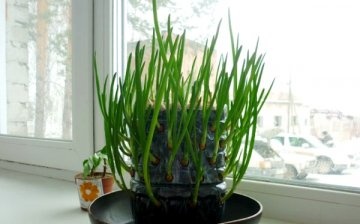
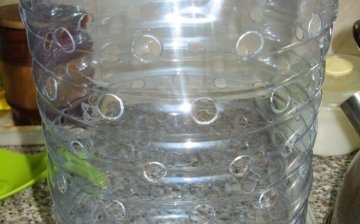
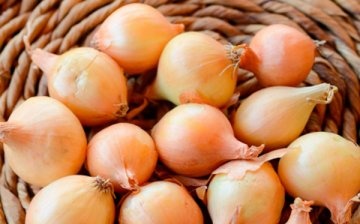
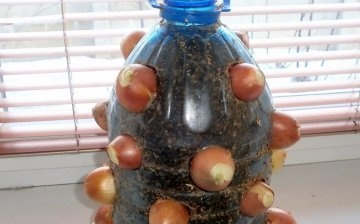
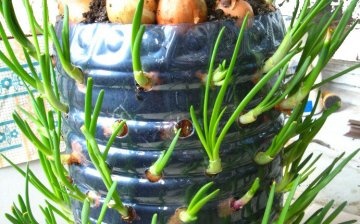
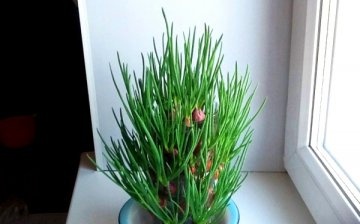






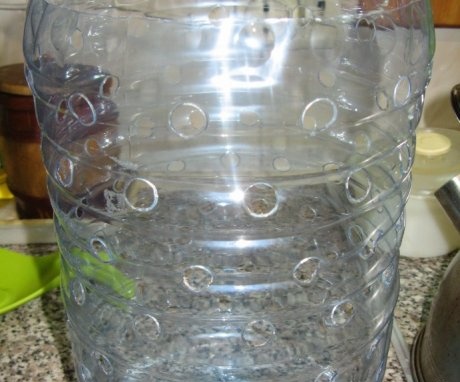

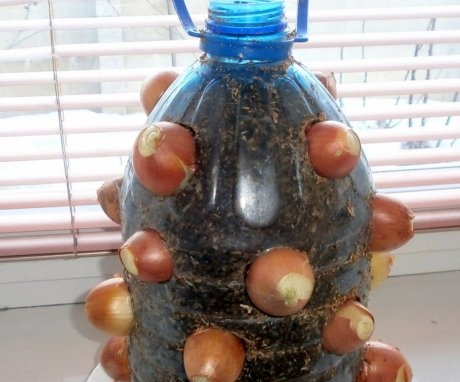
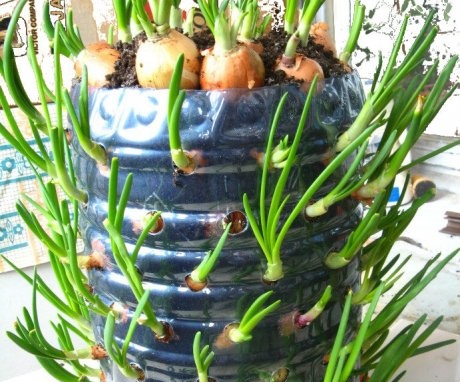
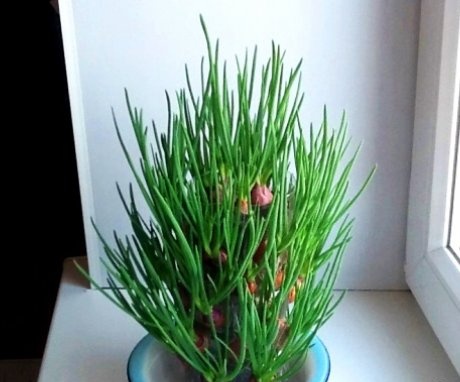
What an interesting idea! I will definitely try. As a child, my mother usually put onions in mayonnaise jars, and later trays with nests for onions appeared. Of course, such an option as in the article is more modern and the harvest can be large.
What a cool building! I never thought it could be! We usually just plant the sprouted bulb in a container of water, and the feathers will grow until the bulb itself is completely rotten. Sometimes we have several such onions - in jars, in cups, etc. stand. Once there was a special tray with soil, which my grandfather brought especially for growing onions on a feather. But he somehow did not take root with us. We grow everything in the country, and at home we care for the sprouted bulbs so as not to throw them away.
And I grow green onions all year round in any plastic form. You can cut off the bottom of a cola bottle, a bucket of mayonnaise. Purely, the earth does not fly over the windowsill. You can buy onion sets all year round in the store. It is healthy and tasty. Especially the pies!
We planted onions in a plastic bottle last year, and this year, around the beginning of April, I planted onions in a cardboard juice box, its capacity is 1 liter. It has a square shape, the water inside does not dry out for a long time. On top of the bag, I had 3 large onions.